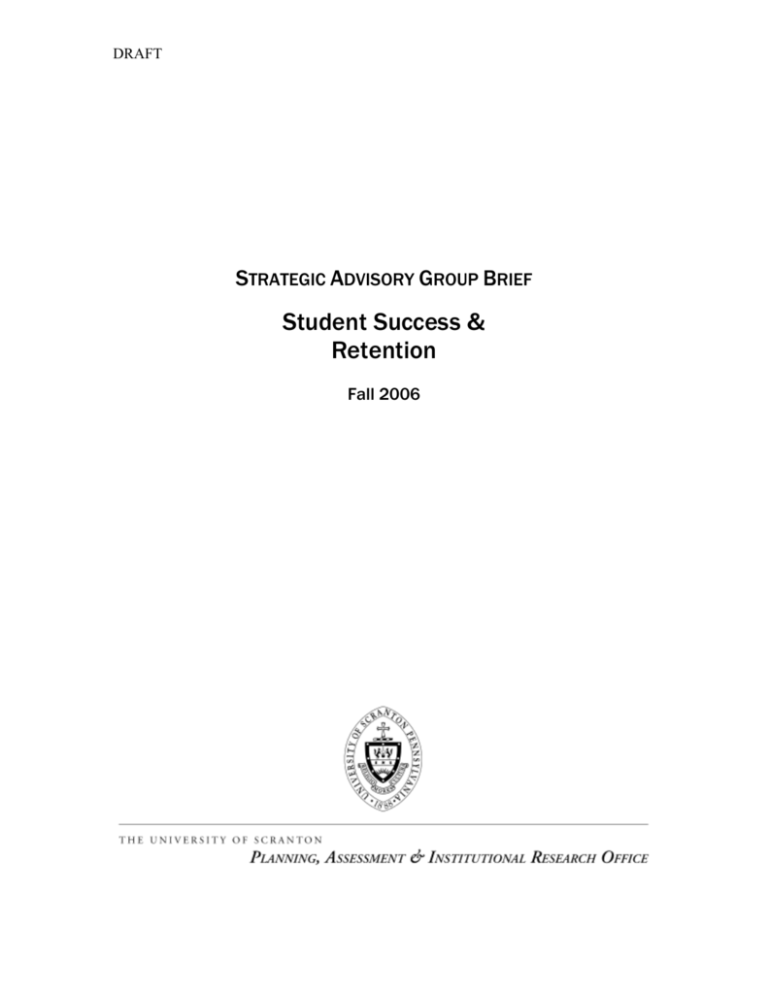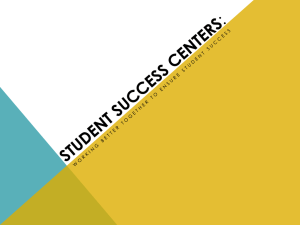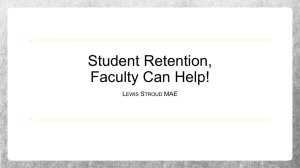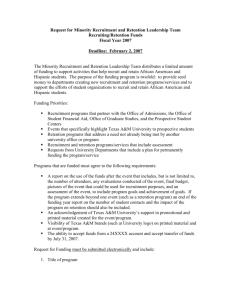Strategic Advisory Group - The University of Scranton
advertisement

DRAFT STRATEGIC ADVISORY GROUP BRIEF Student Success & Retention Fall 2006 Draft TABLE OF CONTENTS Executive Summary ........................................................................................................................ 3 Literature Review: Student Success & Retention ...................................................................... 5 Best Practices in Programming for Student Success ................................................................... 8 Related Internal Assessments ....................................................................................................... 10 Changing Student Characteristics ................................................................................................ 12 Appendix 1: Comparative Retention & Graduation Rate Data ............................................... 14 Works Cited ..................................................................................................................................... 19 Bibliography ..................................................................................................................................... 20 2 Draft Executive Summary Theoretical models of retention show that student commitment to an institution influences their decision to remain enrolled and graduate from that institution. Student’s initial characteristics at entry and the level of social integration that they are able to realize early in their experience at the institution both impact their retention (Berger & Lyon, 2005, p 24). Scholarship on this subject reinforces the idea that institutions need to provide ways for students to integrate into their community and that “… education, not retention, is the primary principle of effective retention” (Tinto, 1990, 35). More recently, this concept of integration has been explained, in practice, as the notion of “student engagement.” Engagement has two components — student effort and institutional commitment. In looking at best practices, researchers have identified six features found within institutions known to have high levels of student engagement (as well as high graduation rates) (Kuh 2005, 24): A “living” mission and “lived” educational philosophy An unshakable focus on student learning Environments adapted for educational enrichment Clearly marked pathways for student success An improvement oriented ethos Shared responsibility for educational quality and student success These features take shape in concrete programs and services such as planned first-year transitions, academic advising, learning communities, faculty mentoring, honors programs, learning support centers and tutoring (ACT, 2004). Institutional commitment to student engagement is also marked by the notion of integration — it is recommended that retention programs be guided by “faculty, staff, academic advisors, and administrators … attend[ing] to the holistic development of the student – both academic and co-curricular – by promoting growth and learning not only in the classroom but in the university community as well” (Braxton and Mundy, 2001-02, 92). Essentially, all aspects of the institution focused on the development of the whole student in the context of their education is what leads to successful retention. From assessments conducted with University of Scranton students, we know that our students report that we provide a supportive campus environment and a purposeful community with regard to our mission and curriculum. We also know that challenges exist with students’ perceptions of advising (goal setting, link with career development), course offerings, residential space, tuition cost, and finding information needed oncampus. In 2004, Noel-Levitz made several recommendations for improving our student engagement and success, all of which can be related to several of the features listed above: creating environments adapted to educational enrichment, creating clearly marked pathways for student success, and creating a shared responsibility for educational quality and student success. This evidence combined with the University’s 3 Draft strong retention and graduation rates (shown in the appendix) echoes many of the findings from the literature sources described in this paper. Both theory and best practice show that student success and healthy retention rates are the result of processes and programming that bring together three core issues – commitment, integration, and education – and emphasize that responsibility for these goals must be shared by both higher education personnel and students. As we look to the changing nature of the students that we will enroll in the future we will need to continue to explore how we engage, retain, and graduate successful students. 4 Draft This paper will present a summary of literature and data related to student success and retention. Key attributes of institutions with successful practices and trends as described in higher education scholarship will be examined, and data reflecting national student retention rates and that of the University of Scranton and selected peers is also presented. The brief has been prepared in collaboration with the Mary Kay Aston, Enrollment Management Information Coordinator. A Review of the Literature: Student Success & Retention Since the 1970’s, conversations about how to ensure that students who enter college stay in college until graduation have played an important role in enrollment, academic, and student services planning. Colleges have become increasingly concerned about student retention rates, primarily those that focus on the return of students from the freshmen to sophomore year. Research from the Consortium for Student Retention Data Exchange (1999) shows that over half of all students who leave college do so before their second year.1 Vincent Tinto (1987), a widely referenced scholar in the field of higher education, developed an interactionalist model describing factors at play in the process of student attrition. The model is based on theories of social integration; it addresses the process towards attrition from the pre-entry attributes of students to their integration (or lack thereof) and procession through the academic system to their voluntary decision to depart (114): Figure 1: Tinto’s model of institutional departure. 1 Cited in: McClanahan, Randy. (2004). Review of Retention Literature. ACT. 5 Draft Tinto describes the primary purpose of this model, to “explain how interactions among different individuals within the academic and social systems of the institution and the communities which comprise them lead individuals of different characteristics to withdraw from that institution prior to degree completion…Though it accepts as a given the fact that individuals have much to do with their own leaving, it argues that the impact of individual attributes cannot be understood without reference to the social and intellectual context within which individuals find themselves” (113). Over the years, researchers have tested and challenged Tinto’s model2; despite some critique, the model still remains a centerpiece of scholarship on student success and retention. Braxton and Hirschy (2004) propose a revised version of Tinto’s model for residential colleges; the revision is based upon closer examination of the factors that influence social integration, as described by Tinto: See: Metz, George W. (2004-05). Challenges and changes to Tinto’s persistence theory: a historical review. Journal of College Student Retention. Braxton, John et al. (2004). Tinto’s interactionist theory. Understanding and Reducing College Student Departure, 7-20. Wiley. 2 6 Draft Braxton and Hirschy identify six factors that influence a student’s integration. These are: the commitment of the institution to student welfare; the communal potential of the institution (the extent to which the student perceives a subgroup exists w/in the institution with which they share similar values, beliefs, and goals); institutional integrity (the extent to which a college or university is true to its espoused mission and goals); proactive social adjustment (a student’s tendency to adjust in a proactive way to demands and pressures of social interaction ); psychosocial engagement (the psychological effort on the part of the student to engage socially); and ability to pay (22-27). If students negotiate these successfully, their chances for integration into the college or university increase, as does the likelihood they will persist. As evidenced by the sources above, and in other research3, student involvement is critical to student success; according to Tinto (1997) “We know that involvement matters. As numerous researchers have pointed out, the greater students’ involvement or integration in the life of the college the greater the likelihood that they will persist. We also know that involvement influences learning. Generally speaking, the greater students’ involvement in the life of the college, especially its academic life, the greater their acquisition of knowledge and development of skills4” (600). Among other findings, Tinto goes on to describe the positive relationship between quality learning communities5 and student persistence, asserting that “it is evident that participation in a collaborative or shared learning group enables students to develop a network of support… that helps bond students to the broader social communities of the college while also engaging them more fully in the academic life of the institution….It is apparent that students are influenced by participating in a setting in which sources of learning come from a variety of perspectives beyond that of one faculty member (61314). George Kuh6 and others emphasize the role of student engagement in ensuring student success. As the authors note, “the best predictors of whether a student will graduate or not are academic preparation and motivation7.” Thus, as the authors assert, admitting only “well-prepared, academically talented students” is the only way to ensure success. However, as the authors continue, “The problem with this approach is obvious…More people from a wider, deeper, and more diverse pool of undergraduates are going to college…admitting only the most talented and well-prepared students is neither a 3 Tinto cites: Astin, 1984; Mallette & Cabrera, 1991; Nora, 1987; Pascarella and Terenzini, 1980; Terenzini & Pascarella, 1977. 4 Tinto cites: Astin, 1984, 1993; Friedlander, 1980; Parker & Schmidt, 1982; Ory and Braskamp, 1988; Pascarella and Terenzini, 1991. 5 Tinto also describes the role of colleges as learning communities in: Leaving College: Rethinking the Causes and Cures of Student Attrition (1987). 6 Kuh is the director of the National Survey of Student Engagement (NSSE) program. The NSSE and its Benchmarks of Educational Practice explore several of the student engagement concepts discussed in this paper. 7 See: Adelman, 2004; Pascarella & Terenzini, 1991, 2005. 7 Draft solution nor an option” (8). The authors point to student engagement as another avenue for enhancing student success; they identify two components of student engagement that contribute to success: “The first is the amount of time and effort students put into their studies and other activities that lead to the experiences and outcomes that constitute success. The second is the ways the institution allocates resources and organizes learning opportunities and services to induce students to participate in and benefit from such activities” (9). In seeking out high-performing colleges and universities in both student engagement and graduation rates, the authors identified twenty institutions8. Six features shared by these institutions are: A “living” mission and “lived” educational philosophy An unshakable focus on student learning Environments adapted for educational enrichment Clearly marked pathways for student success An improvement oriented ethos Shared responsibility for educational quality and student success (24) In another publication, Kuh notes that “among the more promising efforts to enhance student persistence and graduation rates is creating a campus climate in which students feel they belong and are valued, challenged, and affirmed by their peers and teachers” (23). Kuh asserts several factors in an organizational culture and their effects on student persistence: Colleges and universities that have a coherent educational philosophy and value structure and set forth clear expectations for student performance will exert a stronger ‘cultural pull’ by teaching students what is important and by inducing them to act in ways that will help them succeed academically and socially. Institutional cultures that value and celebrate community have higher student satisfaction and retention rates Residential campuses have stronger, more engaging cultures that induce more conforming behavior and lead to higher persistence and graduation rates Students at institutions with strong, coherent cultures learn early on what they are supposed to do to succeed In general, the greater the distance between the values and norms of a particular student subculture and the academic values and expectations espoused by the institution, the more likely it is that subculture members will leave prematurely (27-30) Best Practices in Programming for Student Success Tinto (1990) remarks upon three principles of institutional action that are the “hallmark of effective retention programs” (35). These principles are: 8 For more information on the DEEP institutions and the DEEP project, see Kuh et al. (2005). Student Success in College. 8 Draft The principle of community: effective programs commonly stress the manner in which their actions serve to integrate individuals into the mainstream of the social and intellectual life of the institution and into the communities of people which make up that life. The principle of commitment: effective programs are marked by an enduring commitment to the students they serve. Rather than reflect only institutional interests, they continually ask of themselves how their actions serve to further the welfare of students Third, and most important, the principle “that social and intellectual growth of students, not their mere retention, is the mark of effective retention efforts;” successful retention programs “focus not on the goal of retention but on the broader goal of student education. Education, not retention, is the primary principle of effective retention.” A 2004 report from an ACT survey of all accredited, degree granting, two- and four-year public and private colleges in the nation reveals some attributes of “high-performing colleges”9. These practices which differentiate them from “low-performing colleges”10 include: Integration of academic advising with first-year transition programs Increased advising staff Academic advising center Learning communities Faculty mentoring Non-credit extended freshmen orientation Summer bridge program Program for honors students Peer mentoring Writing center/lab According to the ACT report, “retention practices responsible for the greatest contribution to retention for four-year private colleges fall into three main categories: first year programs: including freshmen seminars/university 101 either for credit or not for credit, learning communities, extended orientation programs and integration of academic advising with first-year programs academic advising: including advising interventions with selected student populations, increased advising staff and integration of advising with first-year transition programs learning support: including a comprehensive learning assistance center/lab, reading center/lab, tutoring program, and summer bridge program” (6) 9 Those performing in the top quartile in both retention and degree completion rates. Those performing in the bottom quartile in both retention and degree completion rates. 10 9 Draft According to Tinto (1993), “retention programs can be assessed according to the following [three] principles” (Braxton et al, 55): 1. Institutions are committed to the students they serve. The welfare of the student is primary. 2. Individuals at institutions are committed to the education of all students (not just some). 3. Individuals at the institution are committed to the development of supportive social and academic communities in which all students are integrated as full members. It is the institution’s obligation (through its programs) to provide ways for students to integrate into the community (Tinto, 146-147). Braxton and Mundy summarize no less than forty-seven recommendations for colleges and universities, gathered from a series of articles featured in the Journal of College Student Retention. The recommendations are ordered around the three principles of Tinto’s model (see page 5), and are guided by the “overarching goal and recommendation” that “faculty, staff, academic advisors, and administrators should attend to the holistic development of the student – both academic and co-curricular – by promoting growth and learning not only in the classroom but in the university community as well” (92). These recommendations impact all areas of the institution, from admissions, to student affairs, residence life, advising, and academic instruction. Also following Tinto’s three principles, Braxton, Hirschy, and McClendon identify various programs with proven success in supporting student success and aiding retention. Programs include: Seattle University’s Collegia Program, which provides gathering space and living-learning communities for commuter students; the University of Arkansas’s Freshmen Academic Support and Tracking program (FAST), which seeks to provide “experiences that would assist students’ integration into the academic community” through a combination of various advising, mentoring, and class cohort learning experiences (61), and the University of Michigan’s Undergraduate Research Opportunity Program, partnering students and faculty in research projects. Literature on the topic of successful student learning, integration, and retention consistently reinforces the assertion that this success depends upon all areas of an institution working together11. Experts also agree that achieving strong retention rates result from just plain good programming. As Tinto (1990) asserts: “In short, successful retention is no more than, but certainly no less than, successful education (47). Internal Assessments: Student Feedback on the Scranton Experience 11 For a listing of general policy guidelines for an integrated approach to institutional policy efforts designed to reduce student attrition, see: Braxton, Hirschy, and McClendon. (2004). Reducing institutional rates of departure. 10 Draft As the data on the presented in the appendix illustrates, the University has strong rates of first-year retention and six-year graduation. However, there may be opportunities for growth in areas related to student success as described by contemporary literature. In order to identify these opportunities, a review of data and information already available to the institution may be helpful. The University regularly surveys its students on many issues related to their experiences while here at Scranton. Some of these surveys and other studies, described on the following pages, address issues mentioned in this report. The National Survey of Student Engagement (2005) 12: Results from this survey were analyzed in several contexts: how University of Scranton student responses compare with those from other institutions13, a review of findings related to the University’s mission, and a review of findings related to the Middle States Standards for accreditation. Some highlights: Of five NSSE benchmarks (level of academic challenge, active and collaborative learning, student-faculty interactions, enriching educational experiences, supportive campus environment), the benchmark with the highest mean for Scranton freshmen was Supportive Campus Environment (64.6). The benchmark with the highest mean for Scranton seniors was also Supportive Campus Environment (62.9). The Supportive Campus Environment benchmark was the only one of the five for which Scranton freshmen reported higher means than Scranton seniors; for each of the other four benchmarks, Scranton seniors had higher means than did freshmen. Noel-Levitz Student Satisfaction Inventory (2005): Results from this survey were analyzed via a gap analysis (referencing the Noel-Levitz Institutional Priorities survey administered to faculty and staff in that same year) identifying strengths and challenges for students and employees. Responses to the following survey questions are considered challenge14 areas for both students and employees: My academic advisor helps me set goals to work toward There are sufficient courses within my program of study available each term Security staff respond quickly to calls for assistance I seldom get the “run-around” when seeking information on this campus In addition to these, responses to the following survey questions are identified as challenge areas by students: Living conditions in the residence halls are comfortable I am able to register for classes I need with few conflicts I receive the help I need to apply my academic major to my career goals There is an adequate selection of food available on campus Tuition paid is a worthwhile investment Academic advising includes career development 12 Kuh et al (2005) explore the NSSE dataset in determining elements of effective educational practice. Respondents from AJCU institutions, Master’s I institutions, and a group average all NSSE respondents. 14 Challenges are defined as being above the midpoint in importance and in the bottom quartile of satisfaction and/or the top quartile of performance gaps. 13 11 Draft University of Scranton Student Climate Survey (2005): key findings in this survey note that, of six survey dimensions (based on Ernest Boyer’s model for campus community), “Overall, student responses on the Inventory indicate agreement that the University does provide the framework necessary for a healthy campus community as measured by the dimensions listed above. The University’s strongest dimension was Mission and Curriculum where five of the seven questions received 90% or more agree/strongly agree responses” (3). This section of the instrument is designed to reveal whether students perceive their community as purposeful. A purposeful community is one in which “students and faculty share learning goals” and where teachers encourage active learning in the classroom and “encourage students to be creative not conforming” (Boyer, 1990, p.12). Specifically, students agreed that the University is committed to academic excellence (9). Telecounseling Survey: Non-returning Freshmen (2004): This internal survey targeting 75 non-returning fall 2004 freshmen, this survey indicated that the primary reasons students chose not to return to the University following their freshmen year were leaving for a different major (23%) or wanting to be closer to home (18%). Results from a similar survey in 2003 indicated the same two reasons as being most common. Noel-Levitz Retention Opportunities Analysis (2004): Commends the institution for its exemplary work in student retention, but identifies several recommendations. The analysis takes into consideration findings from the University’s 2004 Noel-Levitz SSI results. The recommendations address the formation of a permanent retention committee, and also address several issues related to student engagement and success: Improve the consistency and depth of academic advising Create longer-lasting learning communities for all students Ensure sufficient social and residential space for undergraduates to ensure that they always feel Scranton to be a small university that cares about them Closely evaluate the financial profile of incoming students and the impact of financial aid packaging strategies on enrollment and retention Institute an internal marketing campaign to students and parents Incorporate specific retention success factors (early alert and intervention systems; supplemental instruction; student-friendly registration systems; and revised orientation programming with strong faculty development) Refine retention data collection and reporting capabilities Changing Student Characteristics One of the many reasons15 for increased interest in the subject of retention has to do with the fact that the students entering institutions of higher learning are changing. As summarized by Berger and Lyon, “the supply and types of students served by colleges and universities in our country have changed over time, moving from a small, selective, generally homogenous group of privileged individuals to a diverse spectrum 15 For other factors, see Berger and Lyon. (2005) Past to present: a historical look at retention. 12 Draft of individuals numbering in the millions…Levels of preparation, motivation, and other individual characteristics shape the reasons why students attend college and directly impact the chances that students will be retained at particular types of institutions and ultimately persist” (2). The “millennial” group of students has arrived, and with them come “helicopter” parents, all demanding more and more in terms of service and quality (Howe and Strauss)16. The cultural makeup of the nation and the college campus is shifting, with minority populations growing in numbers and representation. And, in a few short years, the number of college-age persons will be less than what it is today; this decrease reminding us that applicant pools will become smaller and more competitive. These and other issues will continue to impact discussions of how we attract, retain, and graduate successful students. 16 See PAIRO environmental scan, “K-12 Education.” (2004). 13 Draft Appendix 1: Data Snapshot: First-year Retention Rates: National, University of Scranton, and Select Peer Averages Table 1 below lists average national retention and graduation rates in 2006, as reported by ACT. This figure reflects an average of the last four year’s rates reported by ACT. The table shows average retention and graduation rates for the University are above national averages. Table 1: ACT Average Retention and Graduation Rates, 2006 ACT Average Retention and Graduation Rates, 2006 National First to Second Year Retention Rate All Bac & Masters Institutions 74.7% Selective Bac/Masters Institutions 82.0% All Bac/Masters/Doc Institutions 82.1% Selective Bac/Masters/Doc Institutions 84.0% MA/1 Professional Private Institutions 74.7% University of Scranton 88.0% st National Persistence to Degree* (3 years Ass; 5 years BA/BS) All Bac & Masters 48.0% Selective Bac/Masters Institutions 64.0% All Bac/Masters/Doc Institutions 59.0% Selective Bac/Masters/Doc Institutions 66.0% MA/1st Professional Private Institutions 56.0% University of Scranton 80.0% *Completion in 5 years for BA/BS Selective = SAT Score Range 1030-1220 Table 2 on the following page illustrates retention rates for selected institutions from the University’s Peer, Competitor, and Aspirant group17. This figure reflects an average of the last four year’s rates as reported to USNews. The average first year retention for the group’s 2003-04 cohort is 88%, matching the University’s rate for that cohort. The retention rates for the 2004-05 cohort are again 88% for both the peer group and the University. Table 3 (page 15) describes six-year gradation rate averages for the peer institutions for both the fall 1998 and 1999 cohorts is 74%, lower than the University’s rates of 80% for both cohorts. 17 See PAIRO for more information. 14 Draft Table 2: PCA Group and University of Scranton Retention Rates Institution (Carnegie Classification) First Year Retention 2003-04 2004-05 College of Holy Cross (Lib Arts) 96% 96% Bucknell University (Lib Arts) 95% 95% College of New Jersey (Masters N) 95% 95% Colgate University (Lib Arts) 94% 94% Lafayette College (Lib Arts) 94% 94% Villanova University (Masters N) 94% 94% Penn State University (Nat’l) 92% 92% Providence College (Masters N) 92% 92% Santa Clara University (Masters W) 92% 92% SUNY Binghamton (Nat’l) 92% 91% Loyola College of Maryland (Masters N) 90% 91% Fordham University (Nat’l) 89% 90% Fairfield University (Masters N) 89% 89% University of Delaware (Nat’l) 89% 89% Marist College (Masters N) 88% 89% St. Joseph’s University (Masters N) 88% 89% University of Scranton (Masters N) 88% 88% Quinnipiac College (Masters N) 86% 87% Ithaca College (Masters N) 87% 87% John Carroll University (Masters MW) 87% 86% Valparaiso University (Masters MW) 87% 86% La Salle University (Masters N) 86% 86% West Chester University of PA (Masters N) 84% 84% Rutgers University (Masters N) 84% 83% Temple University (Nat’l) 82% 83% Bloomsburg University of PA (Masters N) 81% 81% King’s College (Masters N) 81% 81% Marywood University (Masters N) 82% 80% Sacred Heart University (Masters N) 80% 80% Wilkes University (Masters N) 78% 79% East Stroudsburg University of PA (Masters N) 75% 76% Source: U.S. News Rankings, 2006, 2007 edition Note: data from the 2004-05 and 2005-06 Common Data Sets – first year retention rate is for the fall 2003 & 2004 cohorts. 15 Draft Table 3: PCA Group and University of Scranton Graduation Rates Institution (Carnegie Classification) 6 Year Avg. Graduation 1998-2005 1999-2006 Lafayette College (Lib Arts) 86% 94% College of Holy Cross (Lib Arts) 90% 91% Colgate University (Lib Arts) 89% 91% Bucknell University (Lib Arts) 89% 90% Villanova University (Masters N) 85% 85% Providence College (Masters N) 84% 85% Penn State University (Nat’l) 85% 84% Santa Clara University (Masters W) 83% 84% College of New Jersey (Masters N) 82% 82% Loyola College of Maryland (Masters N) 81% 82% University of Scranton (Masters N) 80% 80% Fairfield University (Masters N) 79% 79% University of Delaware (Nat’l) 76% 76% St. Joseph’s University (Masters N) 75% 76% Marist College (Masters N) 73% 75% John Carroll University (Masters MW) 77% 75% Ithaca College (Masters N) 74% 74% SUNY Binghamton (Nat’l) 80% 73% Valparaiso University (Masters MW) 73% 73% La Salle University (Masters N) 72% 72% King’s College (Masters N) 70% 70% Quinnipiac College (Masters N) 68% 68% Fordham University (Nat’l) 78% 67% Marywood University (Masters N) 66% 66% Bloomsburg University of PA (Masters N) 61% 61% West Chester University of PA (Masters N) 59% 59% Rutgers University (Masters N) 55% 59% Sacred Heart University (Masters N) 56% 58% Temple University (Nat’l) 53% 57% Wilkes University (Masters N) 75% 57% East Stroudsburg University of PA (Masters N) 49% 50% Source: U.S. News Rankings, 2006, 2007 edition Note: data from the 2004-05 and 2005-06 Common Data Sets – 6 year graduation rate is for the fall 1998 & 1999 cohorts. Data sorted in descending order by 1999 cohort sis-year rate. 16 Draft Table 4 below describes retention rates for the fall 2004 cohort and graduation rates for the 1999 cohort for participants in the Consortium for Student Retention Data Exchange (CSRDE). University of Scranton rates are above the average for the CSRDE groups featured. Table 4: CSRDE Retention and Graduation Rates, 2006 Consortium for Student Retention Data Exchange (CSRDE), 2006 First-Year Retention Rates All CSRDE Participants Private/Masters I Highly Selective 80% 78% 87% University of Scranton 88% Graduation Rates - 6 Year All CSRDE Participants Private/Masters I Highly Selective 66% 60% 69% University of Scranton 79% Highly Selective = SAT Score > 1100 Table 5 below shows average graduation rates for the 1999 cohort for the University of Scranton and the institutions in its self-selected IPEDS comparison group. The University rate is above the average for the institutions in the group18. Table 5: IPEDS Comparison Group Grad Rates Graduation Rates - 6 Year* Comparison Group 77.0% University of Scranton 79.0% Table 6 on the following page illustrates retention and graduation rates for the University of Scranton from the fall 1996 cohort to the fall 2004 cohort: 18 These institutions are: Creighton University, Fairfield University, Gonzaga University, Ithaca College, John Carroll University, Loyola College in Maryland, Loyola Marymount University, Marist College, Providence College, Quinnipiac University, Saint Joseph’s University, Santa Clara University, Seattle University, The College of New Jersey, The University of Richmond, Villanova University, Wilkes University, and Xavier University. 17 DRAFT Table 6: University of Scranton Retention & Grad Rates, Fall 1996 - Fall 2004 Undergraduate Student Retention and Graduation Rates First-time, Full-time, Baccalaureate Degree-seeking Freshmen: Fall 1996 to Fall 2004 Graduated or Still Attending After Still Attending After Entering Head- Cohort count 1 year 2 years 4 years Fall 1996 Fall 1997 Fall 1998 Fall 1999 Fall 2000 Fall 2001 Fall 2002 Fall 2003 Fall 2004 948 901 873 957 833 1,013 959 975 965 89% 90% 91% 90% 90% 87% 89% 88% 88% 82% 85% 84% 83% 85% 80% 84% 85% 82% 66% 72% 70% 72% 75% 67% Fall 2005 Grad Continued Grad Continued 5 years 13% 11% 11% 8% 13% 10% 77% 81% 80% 79% 81% Grad Continued 6 years 2% 1% 1% 4% 1% 89% Average first-year retention rate = 89%. Average four-year graduation rate = 70% Average six-year graduation rate = 80% The figures in the above table reflect graduation or attendance data as of fall 2005. Entering cohorts represent students who entered as first-time, full-time, baccalaureate degree-seeking freshmen in the fall of the year given. Attendance in subsequent years includes both full-time and part-time students. 78% 82% 80% 79% 1% 0% 3% 0% DRAFT Works Cited American College Testing, Inc. (2004). What works in student retention – four-year private colleges. Berger, Joseph B. and Susan C. Lyon. (2005). Past to present: a historical look at retention. College Student Retention: Formula for Student Success 1-29. Alan Seidman, ed. ACE/Praeger Series on Higher Education. Praeger. Boyer, Ernest. (1990) Campus life: In search of Community. San Francisco: The Carnegie Foundation for the Advancement of Teaching Braxton, John and Amy S. Hirschy. (2004). Toward a revision of Tinto’s theory for residential colleges and universities. Understanding and Reducing Student Departure (21-33). New Jersey: Wiley. Braxton, John, Hirschy, Amy, and Shederick McClendon. (2004). Exemplary student retention programs. ASHE-Eric Higher Education Report. 30, 3, 53-66. Braxton, John, Hirschy, Amy, and Shederick McClendon. (2004). Reducing institutional rates of departure. ASHE-Eric Higher Education Report. 30, 3, 67-78. Braxton, John and Meaghan E. Mundy. (2001-02). Powerful institutional levers to reduce college student departure. Journal of College Student Retention, 3(1), 91-117. Howe, Neil and William Strauss. (2003). Millenials Go to College. Kuh, George. (2001-02). Organizational culture and student persistence: prospects and puzzles. Journal of College Student Retention, 3(1),23-29. Kuh, George et al. (2005). Student success in college: creating conditions that matter. San Francisco: Jossey-Bass. McClanahan, Randy. (2004). Review of retention literature. ACT, Inc. Seidman, Alan. (2005). College student retention: formula for student success. ACE/ Praeger Series on Higher Education. Greenwood. Tinto, Vincent. (1987). Leaving college: rethinking the causes and cures of student attrition. 2nd edition. Chicago: U of Chicago Press. Tinto, Vincent (1990). Principles of effective retention. Journal of the Freshmen Year Experience, 2(1), 35-48. Tinto, Vincent. (1997). Classrooms as communities: exploring the educational character of student persistence. Journal of Higher Education, 68(6), 599-623. The University of Scranton, PAIRO. (2005). PAIRO Report: Educational excellence: a review of the literature. Draft Bibliography: Selected Readings on Student Success and Retention: Astin, Alexander. (1984). Student Involvement: A developmental theory for higher education. Journal of College Student Development, 40(4), 518-529. Bean, John B. (2005). Nine themes of college student retention. College Student Retention: Formula for Student Success 215-243. ACE/Praeger Series on Higher Education. Praeger. Borland, Kenneth (2001-02). Assessing retention: six steps and four paradigms. Journal of College Student Retention, 3(4), 365-379. Cain, David and Gary L. Reynolds. (2006). The impact of facilities on recruitment and retention of students. Facilities Manager, March/April, 54-60. Chickering, A.W. & Gamson, Z.F. (1987). Seven principles for good practice. AAHE Bulletin, 39, 3-7. Consolvo, C. (2002) Building student success through enhanced, coordinated student services. Journal of College Student Development, 34 (2), 284-87. Fontana, L. et al. (2005-06) A strategic model to address issues of student achievement. Journal of College Student Retention, 7(3-4), 201-216. Helland, Patricia A. et al. (2002). The fulfillment of expectations for college and student departure decisions. Journal of College Student Retention, 3(4), 381-396. Lumina Foundation. (2004). Refuse to lose: today’s colleges and universities must work to foster student success. Pascarella, Ernest T. and Patrick T. Terenzini. (2005). How College Affects Students. 2nd ed. San Francisco: Jossey-Bass. Terenzini, Patrick T. and Ernest T. Pascarella. (1994). Living with myths: undergraduate education in America. Change, Jan/Feb, 28-32. Tinto, V. (2006-07) Research and practice of student retention: what next? Journal of College Student Retention, 8(1), 1-19. Selected Readings on Success & Retention for Various Student Populations: Belch, Holley. (2004-05). Retention and students with disabilities. Journal of College Student Retention, 6(1),3-22. Brown, J.A. (2004). Marketing and retention strategies for adult degree programs. New Directions for Adult and Continuing Education PP. San Francisco: Jossey-Bass. 20 Draft Flowers, Lamont A. (2004-05). Retaining African-American students in higher education: an integrative review. Journal of College Student Retention, 6(1), 23-35. Gaither, Gerald H., ed. (2005). Minority retention: What works? New Directions for Institutional Research. San Francisco: Jossey-Bass. Graunke, S.S., et al. (2005). An exploration of the factors that affect the academic success of college sophomores. College Student Journal, 39(2), 367-76. Hernandez, John C. and Mark A. Lopez. (2004-05). Leaking pipeline: issues impacting Latino/a college student retention. Journal of College Student Retention, 6(1), 37-60. Jacoby, Barbara and John Garland. (2004-05). Strategies for enhancing commuter student success. Journal of College Student Retention, 6(1),61-79. Lang, Marvel. (2001-02). Student retention in higher education: some conceptual and programmatic perspectives. Journal of College Student Retention, 3(3), 217-229. Nelson, C.V., et al. (2004). Predicting success of international graduate students in an American university. College and University, 80(103), 19-27. Porter, Stephen R. (2003-04). Understanding retention outcomes: Using multiple data sources to distinguish between dropouts, stopouts, and transfer-outs. Journal of College Student Retention, 5(1), 53-70. Potts, Glenn, Brian Schultz, and Jacque Frost. (2003-04). The effect of freshmen cohort groups on academic performance and retention. Journal of College Student Retention, 5(4),382-395. Sanlo, Ronni. (2004-05). Lesbian, gay, and bisexual college students: risk, resiliency, and retention. Journal of College Student Retention, 6(1), 97-110. Swail, Watson Scott, Kenneth E. Redd and Laura W. Perna. ( 2003). Retaining minority students in higher education: a framework for success. ASHE-ERIC Higher Education Report, 30(2). New York: Wiley. Theresa Ling Yeh. (2004-05). Issues of college persistence between Asian and Asian Pacific American students. Journal of College Student Retention, 6 (1) 81-96. Zurita, Martha. (2004-05). Stopping out and persisting: experiences of Latino undergraduates. Journal of College Student Retention, 6(3), 301-324. 21 Draft 22






